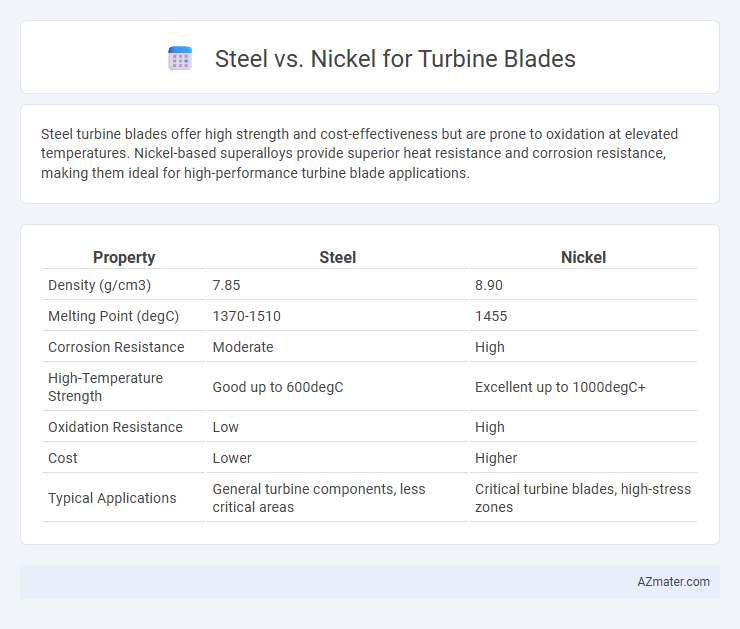Steel turbine blades offer high strength and cost-effectiveness but are prone to oxidation at elevated temperatures. Nickel-based superalloys provide superior heat resistance and corrosion resistance, making them ideal for high-performance turbine blade applications.
Table of Comparison
| Property | Steel | Nickel |
|---|---|---|
| Density (g/cm3) | 7.85 | 8.90 |
| Melting Point (degC) | 1370-1510 | 1455 |
| Corrosion Resistance | Moderate | High |
| High-Temperature Strength | Good up to 600degC | Excellent up to 1000degC+ |
| Oxidation Resistance | Low | High |
| Cost | Lower | Higher |
| Typical Applications | General turbine components, less critical areas | Critical turbine blades, high-stress zones |
Introduction to Turbine Blade Materials
Turbine blades require materials with exceptional strength, heat resistance, and corrosion resistance to withstand extreme operating conditions. Steel alloys offer high mechanical strength and cost-effectiveness but have limitations in temperature tolerance compared to nickel-based superalloys. Nickel alloys exhibit superior high-temperature performance and oxidation resistance, making them the preferred choice for advanced turbine blade applications in aerospace and power generation industries.
Overview of Steel and Nickel Alloys
Steel alloys, known for their high strength, toughness, and cost-effectiveness, are commonly used in turbine blades where moderate temperature resistance is required. Nickel alloys exhibit excellent high-temperature strength, corrosion resistance, and creep resistance, making them the preferred choice for advanced turbine blade applications in extremely high-temperature environments. The selection between steel and nickel alloys depends largely on operating temperatures, mechanical stress, and environmental conditions in turbine engines.
Mechanical Strength Comparison
Nickel-based superalloys exhibit superior mechanical strength compared to steel alloys at high temperatures typical of turbine blade operation, maintaining structural integrity under extreme thermal stress and creep conditions. Steel blades generally possess higher tensile strength at lower temperatures but degrade rapidly due to oxidation and thermal fatigue in turbine environments. The exceptional combination of creep resistance, thermal stability, and corrosion resistance in nickel alloys makes them the preferred choice for high-performance turbine blade manufacturing.
High-Temperature Performance
Nickel alloys outperform steel in turbine blade high-temperature performance due to their superior oxidation resistance and mechanical strength at temperatures exceeding 1000degC. The creep resistance and thermal stability of nickel-based superalloys enable longer service life and efficiency in turbine engines operating under extreme thermal stress. Steel, while more cost-effective, lacks the high-temperature durability required for advanced turbine blade applications.
Corrosion and Oxidation Resistance
Nickel alloys exhibit superior corrosion and oxidation resistance compared to steel, making them more suitable for turbine blades operating in high-temperature and aggressive environments. Steel, especially carbon and low-alloy variants, tends to form less protective oxide layers, resulting in faster degradation and reduced lifespan under oxidative stress. Advanced nickel-based superalloys maintain structural integrity and resist scaling, essential for turbine blade durability and performance in combustion conditions.
Fatigue and Creep Properties
Nickel-based superalloys exhibit superior fatigue resistance and creep strength at high temperatures compared to steel, making them essential for turbine blade applications operating under extreme thermal and mechanical stress. Steel alloys, while offering good fatigue properties at lower temperatures and cost-effectiveness, typically fail to maintain structural integrity under the prolonged high-temperature exposure experienced in turbine engines. The enhanced creep resistance of nickel alloys results from their ability to maintain microstructural stability, including the formation of coherent gamma-prime precipitates that impede dislocation motion during high-temperature creep deformation.
Manufacturing and Cost Considerations
Nickel-based superalloys dominate turbine blade manufacturing due to their exceptional high-temperature strength, corrosion resistance, and creep resistance, enabling longer service life in extreme environments. Steel alloys, while more cost-effective and easier to machine, lack the thermal stability and oxidation resistance required for advanced turbine applications, limiting their use primarily to lower temperature sections. Manufacturing processes for nickel blades often involve investment casting and intricate directional solidification or single crystal growth, increasing production complexity and cost compared to steel components.
Applications in Gas and Steam Turbines
Nickel alloys are preferred for turbine blades in high-temperature gas turbines due to their superior creep resistance, oxidation resistance, and thermal stability compared to steel. Steel alloys, especially stainless steels, find applications in steam turbine blades where temperatures and stresses are lower, offering cost-effective mechanical strength and corrosion resistance. The choice between steel and nickel alloys depends largely on operational temperature ranges and environmental conditions, with nickel alloys dominating in advanced gas turbine engines for improved efficiency and durability.
Environmental and Lifecycle Impact
Steel turbine blades offer durability but generally have higher carbon emissions during production compared to nickel alloys, which, despite being more energy-intensive to extract and refine, provide superior corrosion and heat resistance that extends blade lifespan. Nickel-based alloys enable longer operational cycles and reduced maintenance frequency, lowering overall lifecycle environmental impact by minimizing resource consumption and waste generation. Lifecycle assessments indicate that optimizing material selection between steel and nickel alloys hinges on balancing initial manufacturing emissions against long-term energy efficiency and replacement intervals.
Choosing the Right Material: Steel or Nickel?
Nickel alloys are preferred for turbine blades due to their superior high-temperature strength, corrosion resistance, and ability to maintain mechanical properties under extreme thermal stress. Steel, while more cost-effective and easier to manufacture, lacks the necessary creep resistance and oxidation stability required for high-performance turbine environments. Selecting nickel-based superalloys enhances blade lifespan and efficiency, making them the optimal choice for advanced gas turbines and jet engines.

Infographic: Steel vs Nickel for Turbine Blade
 azmater.com
azmater.com